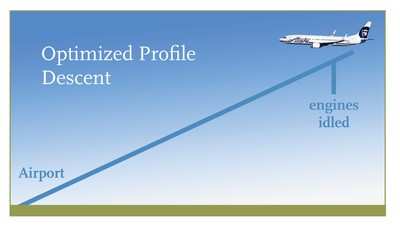Descend and Maintain …
Aircraft inbound to Orlando (MCO), Kansas City (MCI), Omaha (OMA), Reno (RNO) and six additional airports across South Florida may now be authorized to conduct continuous descents from their cruising altitudes to the final segment altitudes of in-use IFR arrival procedures or instrument approaches—thereby conserving millions of pounds of jet fuel and reducing greenhouse gas emissions.

The Federal Aviation Administration’s (FAA) new Optimized Profile Descents (OPDs) eliminate the need for conventional step-down descents into busy, terminal airports. Ordinarily, arriving aircraft negotiate a series of incremental descents and level-offs—often published, but as often dictated by Air Traffic Control (ATC) for purpose of resolving traffic conflicts or facilitating the smooth flow of air traffic. At every level-off, pilots must apply engine power to arrest their aircrafts’ descents. Optimized profile descents permit pilots to descend continuously at low, fuel-saving power settings.
Acting FAA Administrator Billy Nolen stated: “We are investing across the entire system to provide passengers with the best travel experience. The era of choppy descents is coming to an end, providing a smoother landing and saving fuel in the process.”
The FAA, in 2022, implemented OPDs for the following 11 airports: Boca Raton Airport (BCT), Fort Lauderdale Executive Airport (FXE), Kansas City International Airport (MCI), North Palm Beach County General Aviation Airport (LID/F45), Eppley Airfield (OMA), Offutt Air Force Base (OFF), Orlando International Airport (MCO), Palm Beach County Park Airport (LNA), Palm Beach International Airport (PBI), Pompano Beach Airpark (PPM), and Reno/Tahoe International Airport (RNO).
The aforementioned facilities bring the total number of U.S. airports for which the FAA has prescribed OPD procedures to 64.
The FAA estimates OPDs will save the aviation industry upwards of 612,000-pounds (90,000-gallons) of jet fuel yearly, and will reduce greenhouse gas emissions by 27,000-tons annually. The yearly savings equal the amount of fuel required to power a late-model Boeing 737 from New York to Cleveland—62 times.
The United States, by dint of its Aviation Climate Action Plan, has set out to reduce U.S. aviation sector greenhouse gas emissions to net-zero by 2050. To achieve this lofty, if not wholly rational objective, the FAA has:
- Awarded $100-million to research and scale fuel-saving technologies and noise reductions.
- Awarded $327-million to electrify airport gate equipment and vehicles.
- Invested $35-million for universities to help build sustainable aviation fuel supply chains.
- Completed research and testing on reducing fuel-burn and taxi time.
In addition to OPDs, the FAA has implemented a number of next-generation flight procedures that increase the precision of air-routes and reduce fuel-burn. Principal among these is Performance Based Navigation (PBN).

Defined somewhat cumbersomely as “Specifications that aircraft Required Navigation Performance (RNP) and aRea NAVigation (RNAV) systems performance requirements be defined in terms of accuracy, integrity, availability, continuity, and functionality required for the proposed operations in the context of a particular airspace, when supported by the appropriate navigation infrastructure,” Performance Based Navigation reduces the need to and cost of maintaining sensor-specific routes and procedures; circumvents the need for developing sensor-specific operations with each new evolution of navigation systems; allows for more efficient use of airspace; clarifies the manner and extent to which RNAV systems are used; and facilitates the operational approval process for civil aviation authorities by providing a limited set of navigation specifications intended for global use.
Within a given airspace, PBN requirements are affected by the communication, radar surveillance, and air traffic control (ATC) environments; the navaid infrastructure; and functional and operational capabilities required to meet the Air Traffic Management (ATM) application. PBN performance requirements depend, also, on what reversion, non-RNAV means of navigation are available, and what degree of redundancy is required to ensure adequate continuity of operations.
 ANN's Daily Aero-Term (12.14.25): Local Airport Advisory (LAA)
ANN's Daily Aero-Term (12.14.25): Local Airport Advisory (LAA) Airborne 12.08.25: Samaritans Purse Hijack, FAA Med Relief, China Rocket Fail
Airborne 12.08.25: Samaritans Purse Hijack, FAA Med Relief, China Rocket Fail ANN's Daily Aero-Linx (12.15.25)
ANN's Daily Aero-Linx (12.15.25) Airborne 12.10.25: New Gulfstream, ATC Integrator, Outrageous FFZ User Fees
Airborne 12.10.25: New Gulfstream, ATC Integrator, Outrageous FFZ User Fees Airborne-NextGen 12.09.25: Amazon Crash, China Rocket Accident, UAV Black Hawk
Airborne-NextGen 12.09.25: Amazon Crash, China Rocket Accident, UAV Black Hawk




